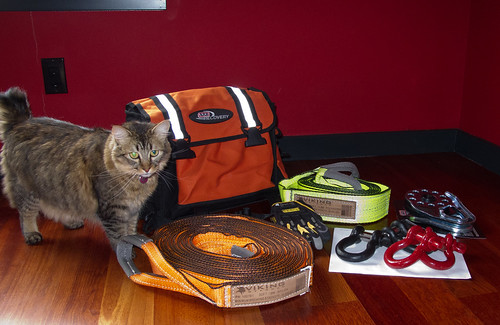Off-road recovery kit
No one should leave the well-groomed roads without some amount of recovery gear. It may not be cheap, but it is way less expensive than getting a tow truck out in to the middle of nowhere (if it is even possible). Plus you won't end up being known as the 'equipment leech' of your group.
Here is what I've put together. You could buy a ready-made kit from any number of sources, but you don't really save anything by doing that. Picking the individual pieces is not difficult, it lets you pick exactly what you want (length/capacity/quantity), and you can buy things in multiple batches so it doesn't cost a fortune all at once. You'll see that I did not buy everything from the same place / same manufacturer.

Going clockwise from the top, we've got a bag to keep everything organized. This is an ARB Large Recovery Bag, purchased from Northridge 4x4. You could use any duffle bag, but this one will help keep things from rubbing (and fraying) or getting tangled up. It has two side pockets for shackles, two wide interior pockets for the straps, a smaller interior pocket for the snatch block, a shoulder strap, and plastic closures that can be snugged down. The two white stripes on it are actually reflective, they are shining from the camera flash here but at night they'll reflect from flashlights to help you find your bag when it falls in the mud.
The bright green strap is a Viking 16 foot tree saver with a 26,500 pound capacity. This strap does not stretch, so you can use it with a winch. Its main purpose is to wrap it around a tree so you don't kill the tree with your winch line (ripping off bark will kill it) and so that you have something appropriate to connect the end of your line too (instead of looping it around and attaching back to itself).
The silver pulley is an ARB Ultra Lite snatch block with a 20,000 pound working strength. It gets used for changing the angle of a winch line, or for doubling your self-pull power by letting you connect the end of your own winch line back to your vehicle.
Then there are four shackles. Shackles let you hook things together in a manner that is safer than using hooks. You could get away with two, but I figure four gives more options in hooking things together, and losing one in the mud won't be as bad. The two red ones are Crosby S-209 3/4" shackles rated to 10,000 pounds. The two black ones were actually stainless steel from my Shrockworks bumper order, they were supposed to have sent the black painted ones, so I just covered them in black plasti-dip. They are rated to 10,000 pounds, but are of unknown origin so I'll be using my Crosby shackles primarily. (And if I need to buy more, I'll continue buying made-in-USA Crosby red-pins)
Next to the shackles is a pair of Mechanix Wear Impact Pro gloves. I'm going with synthetic winch line so I didn't need to get thick leather ones, but these do have nice thick padded palms and rubber guards on the top to help keep your fingers from getting bashed up. You can completely mangle your hand when using winches, so safety is key.
The orange strap is a Viking 2x 2 inch by 30 foot tow strap (aka snatch strap, recovery strap). With two layers of the 2 inch wide webbing the capacity is double, giving 35,000 pounds of strength. These orange snatch / recovery straps are stretchy. The stretch makes them dangerous for winching, but perfect for connecting between two vehicles where one is going to try to yank the other free. ARB's solution is to actually use a 4 inch wide webbing, which makes their version wider by the coil thiner, the coiled size of my Viking strap pretty much fills the ARB recover bag to capacity so getting an additional strap in there might be trouble (but would be the same problem even with an ARB strap, since it would fill the main pocket up width-wise anyway).
Rounding out the kit is Mango, my Pixie-Bob.
This is going to do for now. After I get a winch and decide on the length of line I'll spool on it, I'll decide on what length winch line extension to get. I'll also decide if I need to get a protective sleeve or not. (Some winch lines have sleeves pre-attached.) Other future purchases could include a winch line splice kit to repair damaged lines, and a set of 'spotter lines' which are basically rope with handles that can be attached at any point on your vehicle, including the roll cage, to help manually pull.
I haven't had to use any of this yet, but I think it is a pretty decent kit. Hopefully it helps you make a decision on what things to buy for your own recovery kit.
No comments:
Post a Comment